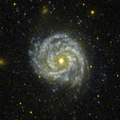Messier 100
| Galaxie Messier 100 / NGC 4321 | |
|---|---|
 | |
| M 100 mit NGC 4322 (l.o) & NGC 4328 (l.u)[1] Aufnahme durch das 1.5 m Danish telescope des La-Silla-Observatoriums der ESO | |
| AladinLite | |
| Sternbild | Haar der Berenike |
| Position Äquinoktium: J2000.0, Epoche: J2000.0 | |
| Rektaszension | 12h 22m 54,8s [2] |
| Deklination | +15° 49′ 19″ [2] |
| Erscheinungsbild | |
| Morphologischer Typ | SAB(s)bc / LINER / HII[2] |
| Helligkeit (visuell) | 9,3 mag[3] |
| Helligkeit (B-Band) | 10,1 mag[3] |
| Winkelausdehnung | 7,5′ × 6,1′[3] |
| Positionswinkel | 30°[3] |
| Flächenhelligkeit | 13,3 mag/arcmin²[3] |
| Physikalische Daten | |
| Zugehörigkeit | Virgo-Cluster Messier 87-Gruppe NGC 4639-Gruppe WBL 401 LGG 289[2][4] |
| Rotverschiebung | 0.005240 ± 0.000003[2] |
| Radialgeschwindigkeit | (1571 ± 1) km/s[2] |
| Hubbledistanz H0 = 73 km/(s • Mpc) | (68 ± 5) · 106 Lj (20,9 ± 1,5) Mpc |
| Durchmesser | 120.000 Lj |
| Geschichte | |
| Entdeckung | Pierre Méchain |
| Entdeckungsdatum | 15. März 1781 |
| Katalogbezeichnungen | |
| NGC 4321 • UGC 7450 • PGC 40153 • CGCG 099-030 • MCG +03-32-015 • IRAS 12204+1605 • KUG 1220+160 • 2MASX J12225489+1549205 • VCC 596 • GC 2890 • h 1211 • GALEXASC J122254.88+154919.1 • LDCE 904 NED074 • HOLM 387A • EVCC 467 | |
Messier 100 = NGC 4321 ist eine aktive Balken-Spiralgalaxie mit ausgedehnten Sternentstehungsgebieten vom Hubble-Typ SBbc im Sternbild Haar der Berenike am Nordsternhimmel. Sie ist schätzungsweise 68 Millionen Lichtjahre von der Milchstraße entfernt. Die Entfernungsmessungen basierend auf den Radialgeschwindigkeiten stimmen nicht mit den rotverschiebungsunabhängigen Entfernungsschätzungen von 53 ± 10 Millionen Lichtjahren überein.
Unter der Katalogbezeichnung VCC 596 wird sie als Mitglied des Virgo-Galaxienhaufens aufgeführt und liegt in dessen äußersten nördlichen Teil. Wie fast alle Spiralgalaxien befindet sich M 100 also weit vom dicht besiedelten Zentrum des Galaxienhaufens entfernt. Unter den Spiralgalaxien dieses Haufens ist sie die hellste.
Im selben Himmelsareal befinden sich u. a. die Galaxien NGC 4312, NGC 4322, NGC 4328, IC 783.
Da ihre galaktische Ebene um mehr als 60 Grad gegen die Sichtlinie geneigt ist, haben wir eine sehr gute Sicht auf die galaktische Scheibe. Dadurch wird sie zu einem idealen Untersuchungsobjekt für alle Fragen, die Spiralgalaxien des Virgo-Haufens betreffen. Insbesondere im H0 Key Project zur Messung der Hubble-Konstante H0 mit dem Hubble-Weltraumteleskop wurde M 100 daher als erste Spiralgalaxie dieses Haufens in Einzelsterne aufgelöst. Im Rahmen dieser Untersuchung konnten Cepheiden identifiziert werden, durch deren Perioden-Leuchtkraft-Beziehung die Entfernung von M 100 auf 55 Millionen Lichtjahre bestimmt werden konnte. Diese Entfernung ist wahrscheinlich etwas geringer als die Entfernung des Haufenzentrums.
Die Supernovae SN 1901B (Typ I), SN 1914A, SN 1959E (Typ I), SN 1979C (Typ IIL), SN 2006X (Typ Ia)[5] und SN2019ehk wurden hier entdeckt, wobei SN 1979C wegen ihrer noch heute anhaltenden Röntgenstrahlung außergewöhnlich ist.
M 100 ist zudem die Hauptgalaxie der kleinen Untergruppe Holm 387 innerhalb des Virgo-Haufens, zu dem weiterhin vornehmlich Zwerggalaxien gehören.
- (c) ESA/Hubble, CC BY 4.0Hochaufgelöste Aufnahme des Zentrums, Hubble-Weltraumteleskop
- Ultraviolettaufnahme mittels GALEX
- Messier 100 im nahen Infrarot und im Millimeterbereich
- (c) NASA, ESA, CSA, STScI, J. Lee (STScI), T. Williams (Oxford), PHANGS Team, CC BY 4.0Infrarotaufnahmen mithilfe des James-Webb-Weltraumteleskops
Entdeckung
Das Objekt wurde am 15. März 1781 von dem französischen Astronomen Pierre Méchain entdeckt.[6]
Literatur
- König, Michael & Binnewies, Stefan (2019): Bildatlas der Galaxien: Die Astrophysik hinter den Astrofotografien, Stuttgart: Kosmos, S. 150
Weblinks
- SIMBAD Astronomical Database
- Core of Messier 100 in super high res (engl.)
- 25 years of stunning definition (engl.)
- Antilhue – Chile
- ESO: A Blast To Chase 23. Februar 2006 (engl.)
- M100
- astronews.com: Die Supernova, die immer weiter leuchtet 25. Juli 2005
- astronews.com: Bild des Tages 29. Juli 2013
- Spektrum.de: Amateuraufnahmen [1][2][3][4]
Einzelnachweise
Auf dieser Seite verwendete Medien
Bildtafel der 110 Messier-Objekte. Diese Datei wird in der w:de:Template:Navigationsleiste Messierobjekte als Imagemap genutzt. Sie darf daher nicht durch eine andere Version überschrieben werden!
NGC 100 by GALEX
Autor/Urheber: Credit: ALMA (ESO/NAOJ/NRAO); NRAO/AUI/NSF, B. Saxton, Lizenz: CC BY 4.0
Starbursts and slow burns
This is one of 74 nearby galaxies whose stellar nurseries were recently observed by the Atacama Large Millimeter/submillimeter Array, or ALMA, in an astronomical census called Physics at High Angular resolution in Nearby GalaxieS (PHANGS). So far, around 100 000 of these stellar nurseries have been imaged in over 750 hours of observation. ALMA’s remarkable sensitivity provides data at high enough resolution to study these regions in detail, and shows that some are bursting with new stars, while others evolve more gradually.
This anticipated diversity in the process of how stars form was the motivation behind this enormous effort. There have long been theories that aimed to explain how and why these differences might occur, some involving the characteristics of the home galaxy itself — properties such as size, age, and internal dynamics — but our lack of high-resolution data had been an obstacle to testing them.
The vast quantity and variety of data yielded by PHANGS are already helping astronomers to understand more, even though the census is only a third complete. The project aims to observe a total of about 300 000 stellar nurseries and by the end it should significantly advance our understanding of how a galaxy’s properties influence the way in which it forms new stars.
Credit:
ALMA (ESO/NAOJ/NRAO); NRAO/AUI/NSF, B. Saxton
Coordinates Position (RA): 12 22 54.26 Position (Dec): 15° 49' 20.09" Field of view: 4.00 x 3.55 arcminutes Orientation: North is -0.0° left of vertical
Colours & filters Band Wavelength Telescope Infrared Y 1.021 μm Very Large Telescope HAWK-I Infrared J 1.258 μm Very Large Telescope HAWK-I Infrared H 1.62 μm Very Large Telescope HAWK-I Infrared Ks 2.146 μm Very Large Telescope HAWK-I Millimeter CO(2-1) 1.2 mm Atacama Large Millimeter/submillimeter Array Band 6.
(c) NASA, ESA, CSA, STScI, J. Lee (STScI), T. Williams (Oxford), PHANGS Team, CC BY 4.0
This spiral galaxy was observed as part of the Physics at High Angular resolution in Nearby GalaxieS (PHANGS) program, a large project that includes observations from several space- and ground-based telescopes of many galaxies to help researchers study all phases of the star formation cycle, from the formation of stars within dusty gas clouds to the energy released in the process that creates the intricate structures revealed by Webb’s new images.NGC 4321 is 56 million light-years away in the constellation Coma Berenices.Learn more about what can be seen in this vast collection of Webb images here.[Image description: Webb’s image of NGC 4321 shows a face-on spiral galaxy anchored by its central region, which is located at far right, midway down, slightly cut off at far right. Darker, filamentary orange arms spiral away counterclockwise, showing only arc shapes.]
Autor/Urheber: ESO/IDA/Danish 1.5 m/R. Gendler, J.-E. Ovaldsen, C. C. Thöne and C. Féron, Lizenz: CC BY 4.0
Similar in appearance to our own Milky Way, Messier 100 is a grand spiral galaxy that presents an intricate structure, with a bright core and two prominent arms. The galaxy harbours numerous young and hot massive stars as well as extremely hot regions of ionised hydrogen. Two smaller arms are seen emerging from the centre and reaching towards the larger spiral arms. The galaxy, located 60 million light-years away, is slightly larger than the Milky Way, with a diameter of about 120,000 light-years. A supernova was discovered in M100 on 4 February 2006. Named SN 2006X, it is the 5th supernova to have been found in M100 since 1900. This image is based on data acquired with the 1.5 m Danish telescope at the ESO La Silla Observatory in Chile, through three filters (B: 1390 s, V: 480 s, R: 245 s). The supernova is the brighter of the two stars seen just to the lower right of the galaxy centre.
(c) ESA/Hubble, CC BY 4.0
This stunning spiral galaxy is Messier 100 in the constellation Coma Berenices, captured here by the NASA/ESA Hubble Space Telescope — not for the first time. Among Hubble’s most striking images of Messier 100 are a pair taken just over a month apart, before and after Servicing Mission 1, which took place 25 years ago in December 1993.
After Hubble was launched, the astronomers and engineers operating the telescope found that the images it returned were fuzzy, as if it were out of focus. In fact, that was exactly what was happening. Hubble’s primary mirror functions like a satellite dish; its curved surface reflects all the light falling on it to a single focal point. However, the mirror suffered from a defect known as a spherical aberration, meaning that the light striking the edges of the mirror was not travelling to the same point as the light from the centre. The result was blurry, unfocused images.
To correct this fault, a team of seven astronauts undertook the first Servicing Mission in December 1993. They installed a device named COSTAR (Corrective Optics Space Telescope Axial Replacement) on Hubble, which took account of this flaw of the mirror and allowed the scientific instruments to correct the images they received. The difference between the photos taken of Messier 100 before and after shows the remarkable effect this had, and the dramatic increase in image quality.
COSTAR was in place on Hubble until Servicing Mission 4, by which time all the original instruments had been replaced. All subsequent instrumentation had corrective optics built in.
This new image of Messier 100 taken with Hubble’s Wide Field Camera 3 (WFC3), demonstrates how much better the latest generation of instruments is compared to the ones installed in Hubble after its launch and after Servicing Mission 1.











